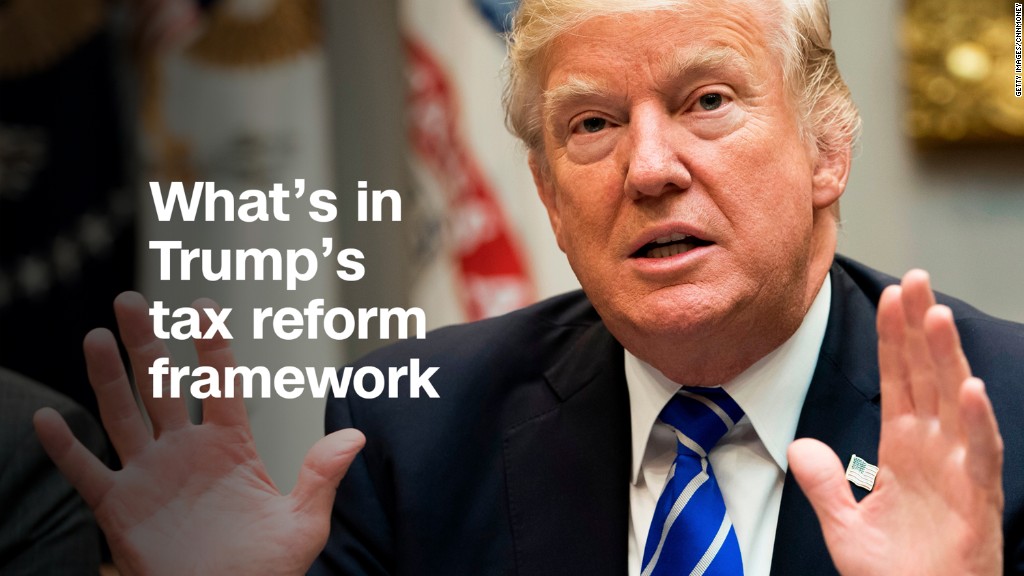
President Trump and Republican leaders in Congress are finally moving to tax reform.
Despite promises to the contrary, they may be hung up on it for a good long while.
The "unified framework" released Wednesday doesn't reveal nearly enough about what a final tax reform package would look like. It represents only a general agreement among six negotiators from the Trump administration, the Senate and the House.
The real work on tax reform will start now as the two tax-writing committees on Capitol Hill separately negotiate provisions, craft legislation and then try to resolve their differences.
"The hardest part lies ahead," said John Gimigliano, principal-in-charge of federal tax legislative and regulatory services at KPMG. "Congress still needs to figure out how to make the math work, both politically and procedurally, and then needs to convert that to legislation."
Translation: Tax writers need to decide on a million details large and small, most of which are politically fraught.
And the process could take months. Or longer.
There's a reason that the last time Congress fully overhauled the tax code, Reagan was president.
Here are five major issues that still must be worked out:
1. How much will tax reform add to deficits
This decision will first fall to the budget committees, which set the budget blueprint for the next year. Chances are very good they will allow tax reform to add to deficits since many Republicans who normally rail against the debt have said they'd be okay with tax cuts that add to it.
The question is how much. On the Senate side, two key members of the Senate Budget Committee agreed to $1.5 trillion in increased deficits over a decade. It's not clear how that will fly in the House.
Related: Details of GOP tax reform framework revealed
Until there's an agreement, "the rest of this is almost an academic exercise. You cannot slice up the pie if you do not know the size of the pie," said Chris Krueger, senior policy analyst at Cowen Washington Research Group.
2. How will lawmakers pay for trillions in tax cuts
Lawmakers are likely to offset at least a portion of the revenue loss by eliminating or curtailing of lots of tax breaks, including some sacred cows.
But deciding on so-called pay-fors can be like political suicide for lawmakers since several may greatly benefit their states' industries and their other constituents.
"One company's loophole is another's business model," Krueger said.
What's more, there really aren't that many breaks that if repealed would bring in a ton of revenue. The biggest (and one of the oldest) on the individual side is the state and local tax deduction. Eliminating it could raise more than $1 trillion over a decade. But there will be a lot of pushback from state and local governments and Republicans and Democrats living in high tax districts.
3. How much income will apply to each income tax rate
The framework calls for there to be just three individual tax rates: 12%, 25% and 35%. That's down from seven rates today: 10%, 15%, 25%, 28%, 33%, 25% and 39.6%.
But the blue print is silent on how much income applies to each of those rates. And that will matter a lot when it comes to determining how people's tax bills would change.
4. Will tax reform really not raise taxes on the middle class
Advocates of the blueprint, including President Trump, promise that reform will offer middle class tax relief and keep the tax code at least as progressive as it is today. That is, it will not shift any of the tax burden from the rich to everyone else.
That will be a tough balance to strike given some of the proposals that Republicans have made almost exclusively benefit the wealthy, like repealing the estate tax and lowering the top individual rate to 35%.
But the blueprint does say lawmakers can add a fourth top rate above the 35% if they need to. If so, the question then becomes how high.
5. How to prevent gaming
The framework recommends lowering the top tax rate on passthrough business income to 25%, well below the 35% rate it proposes for individual income.
Pass-through businesses pass their profits onto owners and shareholders who report them and pay tax on them through their personal tax returns.
But the 10-point gap between the proposed pass-through rate and the ordinary wage income rate could tempt a lot of people to recharacterize their paychecks as profits to get the lower rate.
So lawmakers have to write rules to prevent that kind of gaming. Problem is, those rules are hard to develop and even harder to enforce. Plus, they would complicate the code at a time when lawmakers say they want to simplify it.


